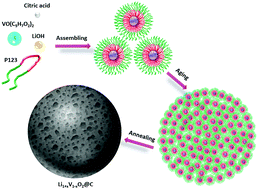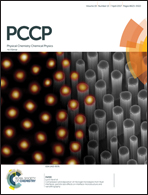Facile synthesis of nanoporous Li1+xV1−xO2@C composites as promising anode materials for lithium-ion batteries†
Abstract
Recently, a layered material with composition Li1+xV1−xO2 has been discovered as a promising alternative anode material to graphite due to its high volumetric capacity and low operation potential. Herein, we demonstrate a mild and cost-effective synthetic methodology to construct a novel nanoporous anode material (P-LVO@C), comprising Li1+xV1−xO2 nanocrystals embedded in a porous carbon matrix. The thermal decomposition of organic materials, including a triblock copolymer (P123) and citric acid, in a N2 atmosphere is the source of the nanoporous carbon in the porous composite material, while citric acid also plays a crucial role in maintaining the reductive environment of the synthetic medium. Due to the novel composition of Li1+xV1−xO2 (x ≥ 0.03), as well as its porous structure and well-integrated conductive framework, our P-LVO@C has great applicability as a high performance anode material for lithium-ion batteries. Our P-LVO@C composite electrode shows high reversible capacity with an excellent cycling performance (100 cycles) and good capacity retention (82%) at a higher rate (0.48C).



 Please wait while we load your content...
Please wait while we load your content...